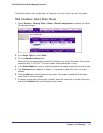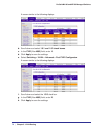
Chapter 6. RIP | 75
6
6. RIP
Routing Information Protocol
This chapter provides the following examples:
• Routing for the Switch on page 76
• Routing for Ports on page 77
• RIP for the Switch on page 78
• RIP for Ports 1/0/2 and 1/0/3 on page 79
• VLAN Routing with RIP on page 82
Routing Information Protocol (RIP) is a protocol that routers can use to exchange network
topology information. It is characterized as an interior gateway protocol, and is typically used in
small to medium-sized networks. A router running RIP sends the contents of its routing table to
each of its adjacent routers every 30 seconds. When a route is removed from the routing table, it
is flagged as unusable by the receiving routers after 180 seconds, and removed from their tables
after an additional 120 seconds.
There are two versions of RIP (the managed switch supports both):
• RIPv1 defined in RFC 1058.
- Routes are specified by IP destination network and hop count.
- The routing table is broadcast to all stations on the attached network.
• RIPv2 defined in RFC 1723.
- Route specification also includes subnet mask and gateway.
- The routing table is sent to a multicast address, reducing network traffic.
- Authentication is used for security.
You can configure a given port to do the following:
• Receive packets in either or both formats.
• Send packets formatted for RIPv1 or RIPv2, or send RIPv2 packets to the RIPv1
broadcast address.
• Prevent any RIP packets from being received.
• Prevent any RIP packets from being sent.


















